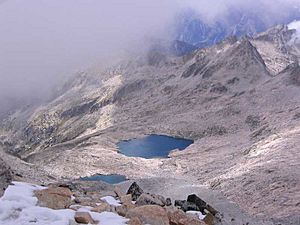Ibón facts for kids
An Ibón is a special kind of small lake found high up in the Pyrenees mountains. The word "Ibón" comes from the Aragonese language, which is spoken in a part of Spain. These lakes are usually found above 2,000 meters (about 6,500 feet) in height.
Ibóns were formed a very long time ago by huge sheets of ice called glaciers. Many of them are important because they are the starting points for rivers and streams in the region of Aragon, Spain.
There are about 94 different Ibóns, and they come in all shapes and sizes. Some of these lakes even help power small hydroelectric plants, which make electricity using water. Some of the most famous Ibóns include Anayet, Sabocos, Ip, and Estanés.
What Does "Ibón" Mean?
The word Ibón most likely comes from an old Basque word, ibai. This word originally meant "river" or even "hot springs." Over time, it came to describe these unique mountain lakes.
How Ibóns Are Formed
Ibóns are created in places where glaciers once existed. When a glacier moves, it carves out a bowl-shaped area in the ground. As the glacier melts, this bowl fills up with water, forming a lake. The size of the Ibón depends on how big the carved-out area is. These lakes are a cool reminder of the Earth's icy past!
Legends and Myths
Local stories and legends say that some Ibóns are enchanted. People believe that fairies live in these magical lakes. For example, the Plan is one such lake where people imagine mystical creatures might live.
See also
 In Spanish: Ibón para niños
In Spanish: Ibón para niños- Lakes in the Pyrenees


